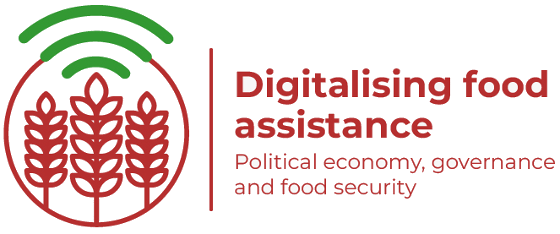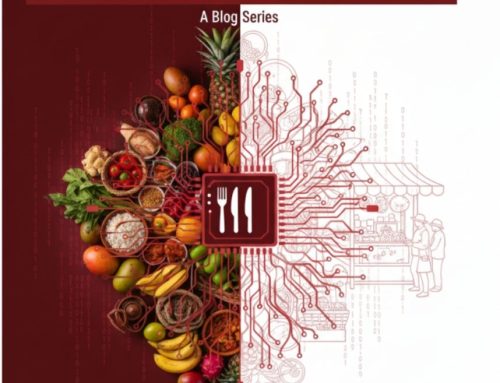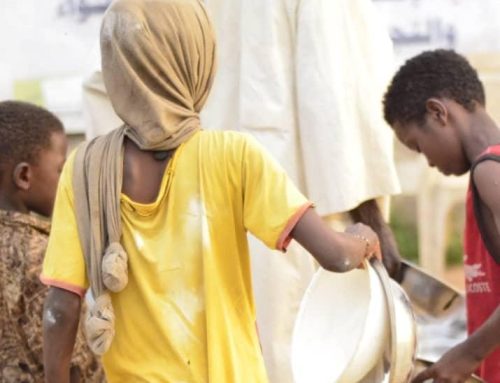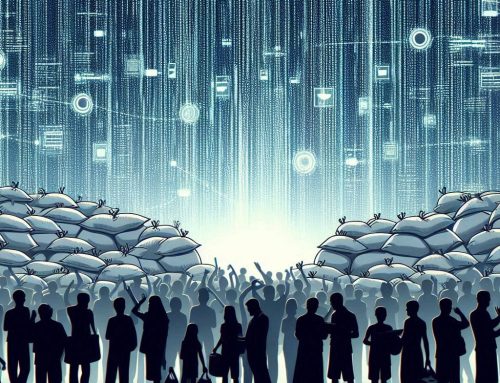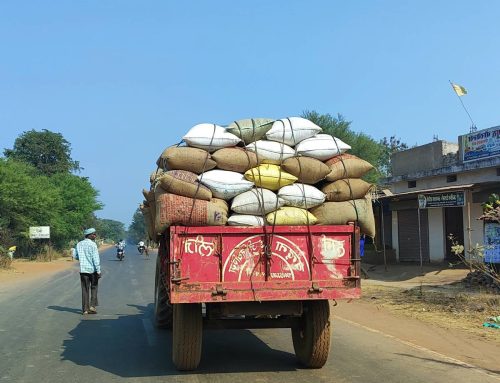The evolution of digital risk in food assistance
Authored by: Susanne Jaspars, C. Sathyamala, Tamer Abd Elkreem, Iris Lim, Somjita Laha
Originally published on 21 November 2023
The past two decades have seen an acceleration in the digitalisation of food assistance and social welfare. With digitalised food assistance we mean the use of digitalised practices towards improving food security: including the use of biometric ID cards, electronic application processes, debit-type cards linked to bank accounts or retail outlets, mobile money transfers, and digital platforms that provide financial and agricultural services. While promoted by governments, business, and aid organisations for reasons of efficiency and accountability, we argue that it comes with a number of risks. We also argue that the trend in digitalisation is part of a long-term global process of financialisation that has the potential to increase food insecurity for some, and that has the underlying objective of capital accumulation. This blog summarises our paper for the World Conference on Humanitarian Studies, presented on 6 November, and which provides some of our initial observations from our ESRC-funded project on ‘Digitalising food assistance: political economy, governance and food security effects across the Global North-South divide’.
Digitalisation in contrasting political and economic contexts
The digitalisation of food assistance can be seen in widely contrasting contexts such as Sudan, India and the UK. We selected these case study countries to reflect the wide range of digital practices used globally, and to compare the interaction between digital practices and different political and economic processes and their effect on food security. It will also enable us to examine the role of global business and international organisations, and global links in trade, aid, migration and finance, through a shared colonial history.
- Sudan has received food aid since 1958 and continuous emergency food aid since the 1980s. Digital food practices were introduced in 2015, with a biometric beneficiary management system and prepaid bank cards. From 2021 mobile money transfers were used in humanitarian assistance and in a government-led social welfare programme. In April 2023, these programmes stalled with the outbreak of violence in Khartoum. At the same time, aid actors are all forced to rely on one functioning electronic banking App to transfer money.
- India has had a Public Distribution System (PDS) of selected food grains to stabilise food prices and support farmers and consumers. The PDS is one of the largest food subsidy welfare measures in the world. From 2009 onwards, the PDS is being digitalised, linking it to the biometric Aadhaar unique identification system for all Indian residents. In some regions, instead of providing food grains, direct cash transfer is being tried out on an experimental basis.
- The UK has had a national welfare system since the Labour government in 1945- 1951. From 2013 government introduced a ‘Digital by Default Service Standard’ in government- effort to bring government services online and have digital delivery be the default way of delivering the service. This included Universal Credit in 2014, as an integrated way of providing social assistance online on a single platform. Assistance for asylum seekers was digitalised in 2017. In 2022, ‘healthy start’ vouchers for pregnant women and those with young children, was digitalised.
How did we get here?
The role of markets in food assistance can be traced back to World War 2 with the Marshall Plan in Europe and the establishment of US programme food aid (wheat aid as loan to Sudan and India). Its role was to create a global market for US produce, to dispose US food surpluses, as well as a foreign policy tool to support ‘friendly’ states.
A technical response to what are essentially political and economic crises also goes back a long way. Changes in US farm laws, a fiscal crisis, and an oil crisis are thought to have been key contributors to the 1974 global food crisis, but food security response focussed on production and nutrition education. With the introduction of neoliberal policies, the role of corporate actors in food systems rose as government support for production and price controls declined. In India, technical response included the ‘Green Revolution’ and was a condition for expansion of US aid to support the PDS. A debt crisis and Structural Adjustment Programmes followed for much of the global South (for instance, the removal of subsidies and privatisation of services in exchange for World Bank/IMF bail-outs). In Sudan, the result was economic crisis and famine, and a rise in externalised welfare through International NGOs in the 1980s. India did not experience debt crisis but still adjusted, privatized and liberalised its economy in exchange for loans. In the UK, Thatcher’s neoliberalism emphasised market efficiency and reduced public spending. It set a precedent for today’s digital government policies which bring in massive savings.
Subsequent decades consolidated the globalisation of food and financial markets. In the 1990s, agriculture was brought into global trade negotiations at the WTO involving the prevention of stockpiling and the reduction of agricultural subsidies. The Uruguay Round (1986-1993) included decisions on the movement of financial services and telecommunications. At national level, this led to a truncated PDS in India through targeting, and in Sudan neoliberal strategies were adopted by ruling Islamists and included the creation of Islamic banks and of military-security linked companies.
From the 2000s, financialisation of the global economy and of everyday life increased, including in food systems. This was in part because regulation of food-linked derivative trading on global financial markets was relaxed, and investment in complex commodity index funds including food, land, fuel, and agribusiness increased. Although opinions vary, speculation in food-based commodity futures markets is generally thought to have contributed to the 2008 global food crisis. It is after this crisis, that we see digitalisation in food assistance accelerate – providing new opportunities to link people to markets and financial institutions. Yet responses after the 2008 crisis were again largely technical, this time also individualising responsibility (for food security), leaving global financial markets, institutions, and elites untouched. Digitalisation has expanded their role and the Covid lockdowns provided a further boost to the use of digital technologies.
Some examples of risk
The risks associated with digital practices include those of exclusion (for example due to lack of connectivity, digital skills, or national ID card), surveillance and breaches of data privacy. From a humanitarian perspective, the involvement of private sector companies for financial services, data management, retail, is likely to compromise humanitarian principles of neutrality and impartiality. In all contexts, motivations for profit rather than welfare may be an issue.
- In Sudan, both humanitarian aid and the formal economy appear to depend on the functioning of a single banking App. This poses a huge risk if this system fails and of monopoly and market manipulation. In the recent past, military leaders controlled telecommunications, were able to shut them down and – later – disable the central banking system. While this affects ordinary people, their own resources are largely outside of the formal economy.
- In India, in late October 2023, the Aadhaar data of 815 million people were leaked in one of the country’s biggest data breaches, with the hacker willing to sell the entire Aadhaar database for $80,000. While Aadhaar which has replaced the previously held ration card is viewed as an important part of the citizen entitlement, the general population is unaware of the implications of data breach and the misuse personal data could be put into.
- The UK’s recent shift to digitalised cards for the Healthy Start programme, has led to exclusions as it is more difficult to apply. It also raises data privacy issues as for automatic enrolment data needs to be shared among different government departments. The risk of exclusion with the digitalised Universal Credit social welfare programme has long been debated.
Some thoughts
Increased dependence by ordinary people on markets and financial institutions has been a long process, and it is imperative to consider its impact on the food security of marginalised populations. Digital food assistance links aid and welfare recipients directly to global financial providers, technology, IT and data management companies, and specific food retail outlets, increasing commercial opportunities for profiteering. The financialisation of food systems (including food assistance) may in fact increase vulnerability to food insecurity through increased exposure to ‘food price volatility, land grabbing, corporate concentration, the individualisation of risk and less secure employment’.
At an individual level, people receiving digitalised food assistance may be more concerned with having their [food or cash] entitlement or documented national identity than risks such as surveillance (whether for economic or political purposes). They may be largely unaware of how their data is used as a commodity or how digital practices enable monitoring of their movement and expenditure. In addition, the individualisation of aid linked to digitalisation makes the structural causes of food insecurity invisible. One issue to consider is whether people actually have any choice in the way in which aid or welfare is provided and therefore being subjected to surveillance and corporate capture. However, since digital practices are here to stay it becomes critical to develop ways of assisting people in navigating their use and to mitigate any harmful effects. We’ll be looking into these issues for the coming 2.5 years.
